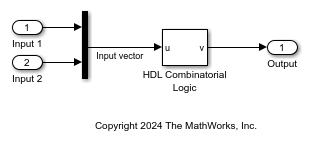HDL Combinatorial Logic
Libraries:
HDL Coder /
RCP and HIL
Description
The HDL Combinatorial Logic block implements a standard truth table for modeling programmable logic arrays (PLAs), logic circuits, decision tables, and other Boolean expressions. You can use this block in conjunction with Memory blocks to implement finite-state machines or flip-flops.
Examples
This example builds a two-input AND function by using the HDL Combinatorial Logic block, which returns 1 when both input elements are 1, and 0 otherwise.
To implement this function, specify the Input table parameter value as logical([0 0; 0 1; 1 0; 1 1]) and the Output table parameter value as logical([0; 0; 0; 1]) in the HDL Combinatorial Logic block of this model.
open_system("HDLCombinatorialLogicBlockExample");

The following table shows the permutations of inputs that generate each output. The input signal labeled Input vector corresponds to the Input Vector columns in the table. The input values determine the row of the Output column of the table that is passed as block output. For example, if Input vector is [1 0], the input references the third row and the output value is 0.

Ports
Input
Input signal, specified as a vector. The type of signals accepted by an HDL
Combinatorial Logic block depends on whether you selected the Boolean logic
signals option (see Implement logic signals as Boolean data (vs. double)). If this option is
enabled, the block accepts real signals of type Boolean or
double.
Data Types: double | Boolean
Output
Output signal, returned as a double scalar or vector if the
truth table represented by Input table and Output
table contains non-Boolean values of type double; or
returned as Boolean scalar or vector otherwise. The type of the
output is the same as that of the input except that the block outputs
double if the input is Boolean and the truth
table contains non-Boolean values.
Data Types: double | Boolean
Parameters
The Input table parameter can have Boolean values (0 or 1) of
any data type, including fixed-point data types. If the table contains non-Boolean
values, the data type of the table must be double.
The relationship between the number of inputs and the number of rows is:
number of rows = 2(number of inputs)
Simulink® returns a row of the output matrix specified by Output
table by computing number based on the input vector elements. Simulink computes the index by building a binary number where input vector elements
having zero values are 0 and elements having nonzero values are 1, then adding 1 to the
result. For an input vector, u, of m
elements:
row index = 1 + u(m)×20+ u(m-1)×21+ ... + u(1)×2m-1
Programmatic Use
Block Parameter:
inputTable |
| Type: character vector |
| Values: matrix |
Default: logical([0 1; 1 0; 1
1]) |
The Output table parameter can have Boolean values (0 or 1) of
any data type, including fixed-point data types. If the table contains non-Boolean
values, the data type of the table must be double.
Programmatic Use
Block Parameter:
outputTable |
| Type: character vector |
| Values: matrix |
Default: logical([1 0; 1 0; 1
1]) |
Extended Capabilities
HDL Code Generation
Generate VHDL, Verilog and SystemVerilog code for FPGA and ASIC designs using HDL Coder™.
Version History
Introduced in R2024b
See Also
MATLAB Command
You clicked a link that corresponds to this MATLAB command:
Run the command by entering it in the MATLAB Command Window. Web browsers do not support MATLAB commands.
Seleziona un sito web
Seleziona un sito web per visualizzare contenuto tradotto dove disponibile e vedere eventi e offerte locali. In base alla tua area geografica, ti consigliamo di selezionare: .
Puoi anche selezionare un sito web dal seguente elenco:
Come ottenere le migliori prestazioni del sito
Per ottenere le migliori prestazioni del sito, seleziona il sito cinese (in cinese o in inglese). I siti MathWorks per gli altri paesi non sono ottimizzati per essere visitati dalla tua area geografica.
Americhe
- América Latina (Español)
- Canada (English)
- United States (English)
Europa
- Belgium (English)
- Denmark (English)
- Deutschland (Deutsch)
- España (Español)
- Finland (English)
- France (Français)
- Ireland (English)
- Italia (Italiano)
- Luxembourg (English)
- Netherlands (English)
- Norway (English)
- Österreich (Deutsch)
- Portugal (English)
- Sweden (English)
- Switzerland
- United Kingdom (English)